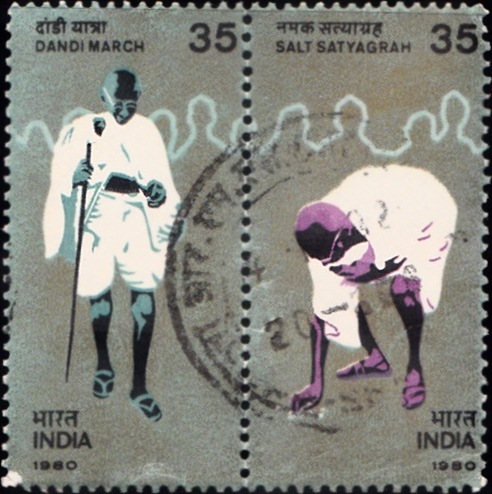
Dandi March 1980
Complete Set of 2 nos of postage stamps on the 50th Anniversary of Dandi Satyagraha : Salt March, a nonviolent civil disobedience movement in British colonial India led by Mahatma Gandhi :

Issued by India
Issued on Oct 2, 1980
Issued for : Indian Posts and Telegraphs Department feels honoured to pay homage to the Father of our Nation by issuing a set of two se-tenant stamps.
Description of Designs : The se-tenant set of two stamps depicts Gandhiji marching to Dandi and defying the Salt law by picking up a handful of salt at Dandi. The first day cover designed by Charanjit Lal shows the facsimile of Gandhiji‘s message to the world together with artist’s impression of Gandhiji‘s marching feet against the background of a crowd scene symbolising nation’s solidarity with the Mahatma‘s March. First day cancellation has the profile of Mahatma Gandhi with the inscriptions in Hindi and English.
Designed by : A. Ramachandran
Type : Se–tenant pair of 2 Stamps, Postal Used
Colour : Multicolour
Denomination : 35 Paise each
Overall size : 4.15 x 4.06 cms.
Printing size : 4.15 x 4.06 cms.
Perforation : 14½ x 14
Watermark : Printed on unwatermarked adhesive stamp paper
Number printed : 20,00,000 each
Number per issue sheet : 25 (se-tenant)
Printing process : Photogravure
Printed at : India Security Press
About :
- “Today the pilgrim marches onward on his long trek. Staff in hand he goes along the dusty roads of Gujarat, clear–eyed and firm of step, with his faithful band trudging along behind him….” – Jawaharlal Nehru.
- In the annals of India’s struggle for independence, few events are as dramatic, inspiring and significant as the historic march to Dandi led by the Father of our Nation, Mahatma Gandhi.
- In December 1929, the Indian National Congress declared Purna Swaraj (total independence) as its avowed objective and 26 January 1930 was celebrated as Independence Day throughout the country. Against this background, Gandhiji launched the civil disobedience movement known as Salt Satyagraha. Before commencing the movement, he addressed a historic letter to the Viceroy of India. The unfeeling reply from the Viceroy provoked Gandhiji to exclaim : “On bended knees I asked for bread and I have received stone instead”.
- The place selected by Gandhiji for his symbolic defiance of the provisions of the Salt law was Dandi, a seaside village in Gujarat. He decided to march the entire distance of about 385 kilometres (241 miles) from Ahmedabad. The great and historic march commenced at 6:30 in the morning on 12 March 1930 from his ashram on the banks of Sabarmati river at Ahmedabad. Frail but full of energy even at the age of 61, Gandhiji led a band of 78 satyagrahis representing a cross-section of the people from all over the country. Daily he walked 16 kilometres (10 miles) or more and addressed public meetings. The ashram routine of prayer, spinning and writing the daily diary was incumbent on every marcher. Unprecedented scenes of enthusiasm were witnessed all along the route of the march.
- The long trek finally ended on 5 April 1930. Along the way Gandhiji and his companions had halted for the night at 22 places. On 6 April, the atmosphere at Dandi was both tense and solemn. After prayers, Gandhiji and his followers bathed in the sea and then at 8:30 in the morning, he bent down and picked up a handful of salt. Sarojini Naidu, who was there, hailed him as a ‘law–breaker’.
- The first salvo was thus fired. The entire nation rallied to his call and millions defied Salt Law and courted imprisonment. Jawaharlal Nehru was arrested on April 14 and sentenced to 6 months’ imprisonment. At 12:45 a.m. on May 4, Gandhiji was arrested at Karadi, 3 miles (5 kilometres) from Dandi, and was sent to Yervada prison. Thus, ended a glorious episode in India’s struggle for freedom. The Dandi March was the spark that kindled the flames of a movement that culminated in independence of the country.


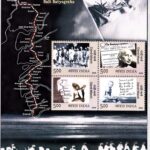
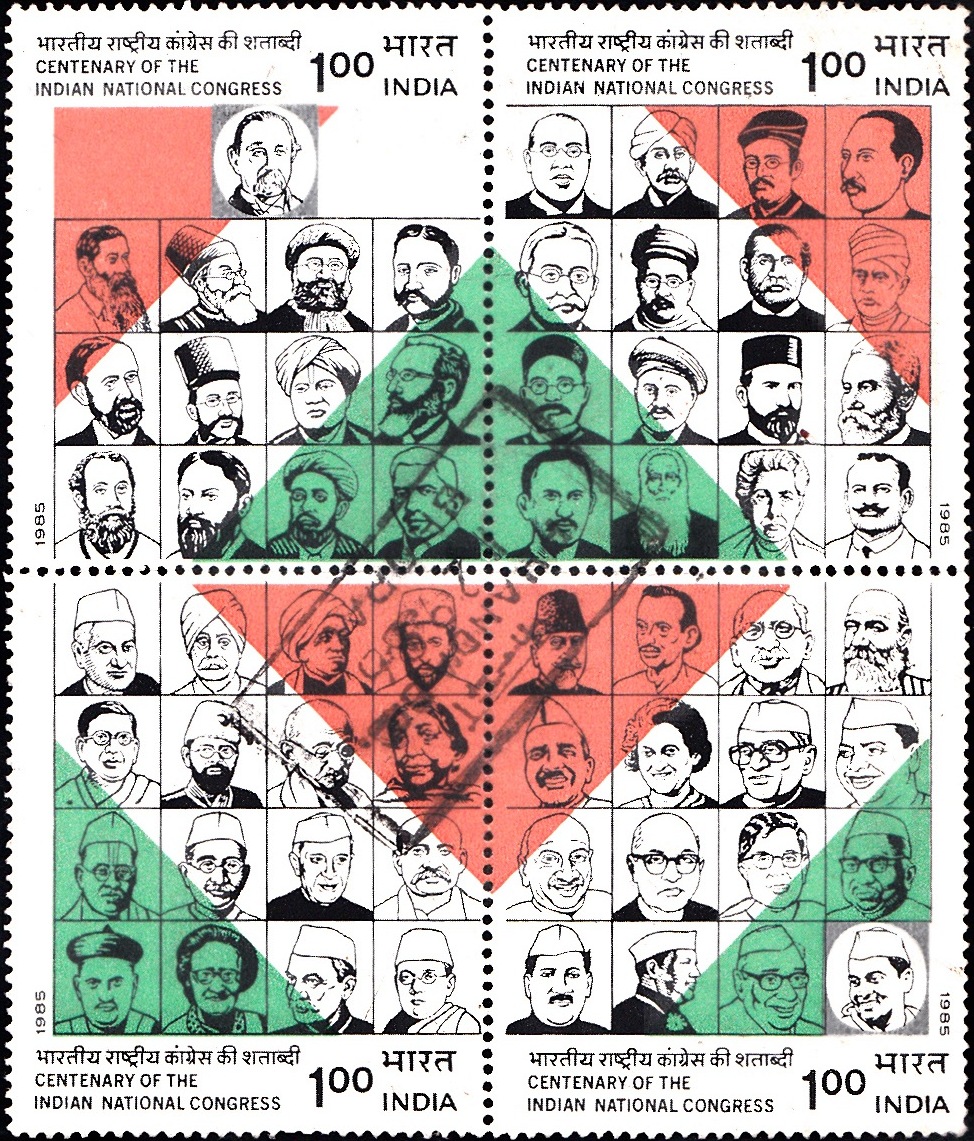
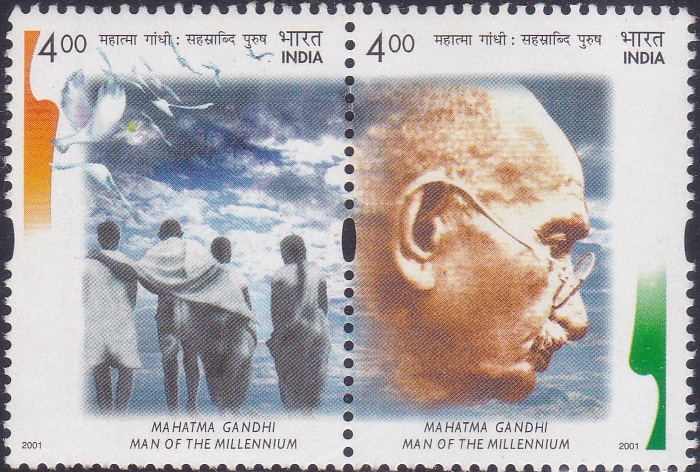
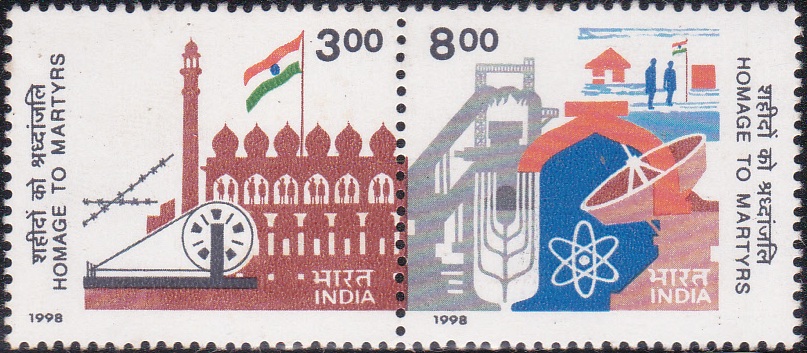
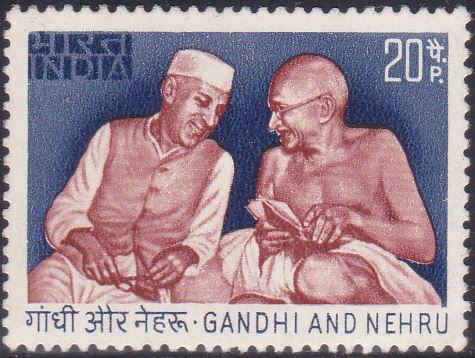

[…] Design : The stamp designs symbolically depict the contributions of Sardar Ajit Singh, Swami Ramanand Teerth, Swami Keshawanand and Vishwambhar Dayalu Tripathi towards India‘s struggle for freedom. The first day cover shows a memorable scene from the freedom struggle, the ‘Dandi March‘. […]
[…] Design : The stamp designs symbolically depict the contributions of Sardar Ajit Singh, Swami Ramanand Teerth, Swami Keshawanand and Vishwambhar Dayalu Tripathi towards India‘s struggle for freedom. The first day cover shows a memorable scene from the freedom struggle, the ‘Dandi March‘. […]
[…] Design : The stamp designs symbolically depict the contributions of Sardar Ajit Singh, Swami Ramanand Teerth, Swami Keshawanand and Vishwambhar Dayalu Tripathi towards India‘s struggle for freedom. The first day cover shows a memorable scene from the freedom struggle, the ‘Dandi March‘. […]
[…] Design : The stamp designs symbolically depict the contributions of Sardar Ajit Singh, Swami Ramanand Teerth, Swami Keshawanand and Vishwambhar Dayalu Tripathi towards India‘s struggle for freedom. The first day cover shows a memorable scene from the freedom struggle, the ‘Dandi March‘. […]
[…] Ganesh Agarkar & Mahatma Gandhi and got involved in the Freedom Movement. He participated in Salt Agitation and Quit India movement. He was put in Shivani Jail. He came to Amravati (Maharashtra) in 1917 […]
[…] and yet effective in rousing the nation. It was on 12th March, 1930 that Gandhiji set off for Dandi and began the Salt Satyagraha which history records as a unique protest – so simple and yet so […]
[…] up a pledge for the complete independence of India. On 12th March, 1930 he began his famous Dandi march to fight against the unjust salt law. The British Government invited him to a Round Table […]
[…] Led Dandi March to collect salt in protest of the British Salt […]
[…] also wrote a hundred poems with patriotic fervour named ‘Nattu Kummi‘. During the 1930 Salt Satyagraha, the Satyagrahis led by Shri Rajagopalachari, marched from Tiruchi to Vedaranyam, singing a song […]
[…] up all her jewellery to the Harijan Welfare Fund of Gandhiji. She further participated in the Salt Satyagraha in 1931 at Vedaranayam and was sentenced to one year’s imprisonment. She was arrested in the […]
[…] Jadhav was a great freedom fighter. In 1930 when the Civil Disobedience movement was launched, he was entrusted with the task of sending secret messages to volunteers by the […]
[…] credentials were recognised by one and all. Husain Ahmad Madani also took an active part in the Civil Disobedience Movement in 1932 and in Quit India Movement in 1942 and was imprisoned on many […]
[…] always about him, a ministering angel.” She was with him during the historic Dandi march of April 1930. She led the famous Satyagraha raid on the Dharasana Salt Pans. She accompanied him […]
[…] to participate in the Harijan Temple Entry Satyagraha. He participated in the famous ‘Dandi March‘ for Salt Satyagraha in 1930, for which he was again sent to […]
[…] then launched the salt Satyagraha in March 1930 and undertook the famous Salt March to Dandi from 12 March to 6 April, where, together with 78 volunteers, he marched 388 kilometres […]
[…] of Design : The stamp depicts Gandhiji on the Dandi March Designed by : India Security Press on the basis of the wood-cut by Nandalal Bose Colour : Bronze […]